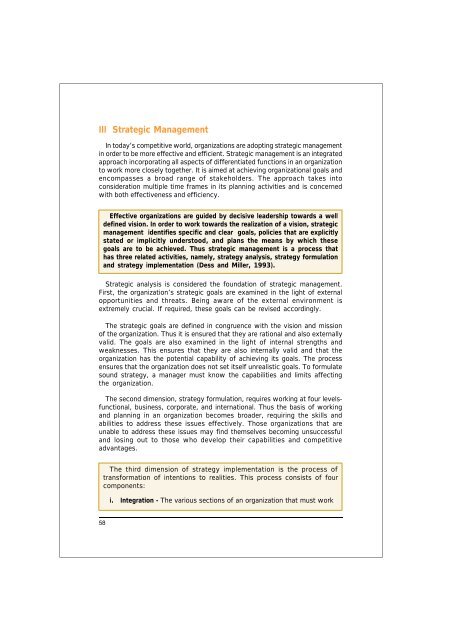Beyond Glass Ceilings and Brick Walls - International Labour ...
Beyond Glass Ceilings and Brick Walls - International Labour ...
Beyond Glass Ceilings and Brick Walls - International Labour ...
You also want an ePaper? Increase the reach of your titles
YUMPU automatically turns print PDFs into web optimized ePapers that Google loves.
III Strategic Management<br />
In today’s competitive world, organizations are adopting strategic management<br />
in order to be more effective <strong>and</strong> efficient. Strategic management is an integrated<br />
approach incorporating all aspects of differentiated functions in an organization<br />
to work more closely together. It is aimed at achieving organizational goals <strong>and</strong><br />
encompasses a broad range of stakeholders. The approach takes into<br />
consideration multiple time frames in its planning activities <strong>and</strong> is concerned<br />
with both effectiveness <strong>and</strong> efficiency.<br />
Effective organizations are guided by decisive leadership towards a well<br />
defined vision. In order to work towards the realization of a vision, strategic<br />
management identifies specific <strong>and</strong> clear goals, policies that are explicitly<br />
stated or implicitly understood, <strong>and</strong> plans the means by which these<br />
goals are to be achieved. Thus strategic management is a process that<br />
has three related activities, namely, strategy analysis, strategy formulation<br />
<strong>and</strong> strategy implementation (Dess <strong>and</strong> Miller, 1993).<br />
Strategic analysis is considered the foundation of strategic management.<br />
First, the organization’s strategic goals are examined in the light of external<br />
opportunities <strong>and</strong> threats. Being aware of the external environment is<br />
extremely crucial. If required, these goals can be revised accordingly.<br />
The strategic goals are defined in congruence with the vision <strong>and</strong> mission<br />
of the organization. Thus it is ensured that they are rational <strong>and</strong> also externally<br />
valid. The goals are also examined in the light of internal strengths <strong>and</strong><br />
weaknesses. This ensures that they are also internally valid <strong>and</strong> that the<br />
organization has the potential capability of achieving its goals. The process<br />
ensures that the organization does not set itself unrealistic goals. To formulate<br />
sound strategy, a manager must know the capabilities <strong>and</strong> limits affecting<br />
the organization.<br />
The second dimension, strategy formulation, requires working at four levelsfunctional,<br />
business, corporate, <strong>and</strong> international. Thus the basis of working<br />
<strong>and</strong> planning in an organization becomes broader, requiring the skills <strong>and</strong><br />
abilities to address these issues effectively. Those organizations that are<br />
unable to address these issues may find themselves becoming unsuccessful<br />
<strong>and</strong> losing out to those who develop their capabilities <strong>and</strong> competitive<br />
advantages.<br />
The third dimension of strategy implementation is the process of<br />
transformation of intentions to realities. This process consists of four<br />
components:<br />
i. Integration - The various sections of an organization that must work<br />
58
















